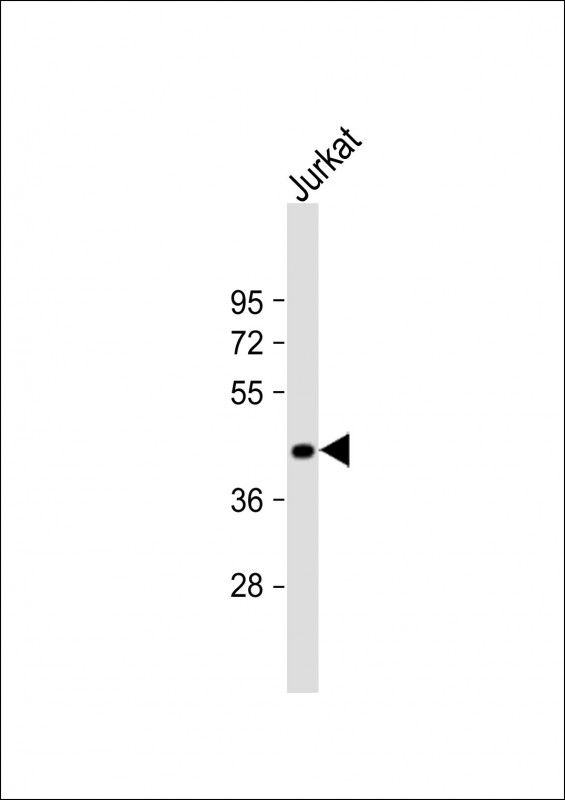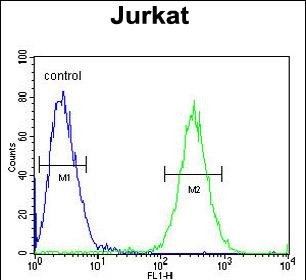ST3GAL5 Antibody (C-term)
Affinity Purified Rabbit Polyclonal Antibody (Pab)
- SPECIFICATION
- CITATIONS: 1
- PROTOCOLS
- BACKGROUND

Application
| FC, IHC-P, WB, E |
|---|---|
| Primary Accession | Q9UNP4 |
| Other Accession | NP_003887.3, NP_001035902.1 |
| Reactivity | Human |
| Host | Rabbit |
| Clonality | Polyclonal |
| Isotype | Rabbit IgG |
| Calculated MW | 47990 Da |
| Antigen Region | 389-418 aa |
| Gene ID | 8869 |
|---|---|
| Other Names | Lactosylceramide alpha-2, 3-sialyltransferase, CMP-NeuAc:lactosylceramide alpha-2, 3-sialyltransferase, Ganglioside GM3 synthase, ST3Gal V, ST3GalV, Sialyltransferase 9, ST3GAL5, SIAT9 |
| Target/Specificity | This ST3GAL5 antibody is generated from rabbits immunized with a KLH conjugated synthetic peptide between 389-418 amino acids of human ST3GAL5. |
| Dilution | FC~~1:10~50 IHC-P~~1:50~100 WB~~1:1000 E~~Use at an assay dependent concentration. |
| Format | Purified polyclonal antibody supplied in PBS with 0.09% (W/V) sodium azide. This antibody is purified through a protein A column, followed by peptide affinity purification. |
| Storage | Maintain refrigerated at 2-8°C for up to 2 weeks. For long term storage store at -20°C in small aliquots to prevent freeze-thaw cycles. |
| Precautions | ST3GAL5 Antibody (C-term) is for research use only and not for use in diagnostic or therapeutic procedures. |
| Name | ST3GAL5 |
|---|---|
| Synonyms | SIAT9 |
| Function | Transfers the sialyl group (N-acetyl-alpha-neuraminyl or NeuAc) from CMP-NeuAc to the non-reducing terminal galactose (Gal) of glycosphingolipids forming gangliosides (important molecules involved in the regulation of multiple cellular processes, including cell proliferation and differentiation, apoptosis, embryogenesis, development, and oncogenesis) (PubMed:16934889, PubMed:9822625). Mainly involved in the biosynthesis of ganglioside GM3 but can also use different glycolipids as substrate acceptors such as D- galactosylceramide (GalCer), asialo-GM2 (GA2) and asialo-GM1 (GA1), although less preferentially than beta-D-Gal-(1->4)-beta-D-Glc-(1<->1)- Cer (LacCer) (PubMed:16934889). |
| Cellular Location | Golgi apparatus membrane; Single- pass type II membrane protein |
| Tissue Location | Ubiquitous. High expression in brain, skeletal muscle, placenta, and testis. mRNA widely distributed in human brain, but slightly elevated expression was observed in the cerebral cortex, temporal lobe, and putamen. |

Provided below are standard protocols that you may find useful for product applications.
If you have used an Abcepta product and would like to share how it has performed, please click on the "Submit Review" button and provide the requested information. Our staff will examine and post your review and contact you if needed.
If you have any additional inquiries please email technical services at tech@abcepta.com.














 Foundational characteristics of cancer include proliferation, angiogenesis, migration, evasion of apoptosis, and cellular immortality. Find key markers for these cellular processes and antibodies to detect them.
Foundational characteristics of cancer include proliferation, angiogenesis, migration, evasion of apoptosis, and cellular immortality. Find key markers for these cellular processes and antibodies to detect them. The SUMOplot™ Analysis Program predicts and scores sumoylation sites in your protein. SUMOylation is a post-translational modification involved in various cellular processes, such as nuclear-cytosolic transport, transcriptional regulation, apoptosis, protein stability, response to stress, and progression through the cell cycle.
The SUMOplot™ Analysis Program predicts and scores sumoylation sites in your protein. SUMOylation is a post-translational modification involved in various cellular processes, such as nuclear-cytosolic transport, transcriptional regulation, apoptosis, protein stability, response to stress, and progression through the cell cycle. The Autophagy Receptor Motif Plotter predicts and scores autophagy receptor binding sites in your protein. Identifying proteins connected to this pathway is critical to understanding the role of autophagy in physiological as well as pathological processes such as development, differentiation, neurodegenerative diseases, stress, infection, and cancer.
The Autophagy Receptor Motif Plotter predicts and scores autophagy receptor binding sites in your protein. Identifying proteins connected to this pathway is critical to understanding the role of autophagy in physiological as well as pathological processes such as development, differentiation, neurodegenerative diseases, stress, infection, and cancer.



